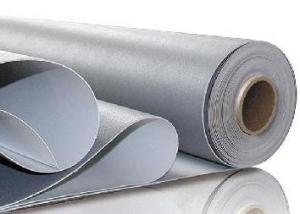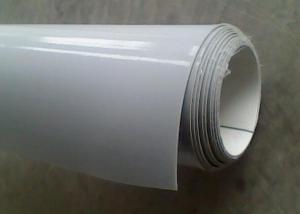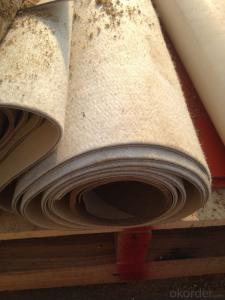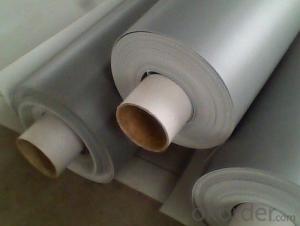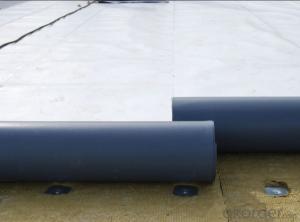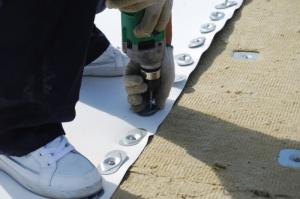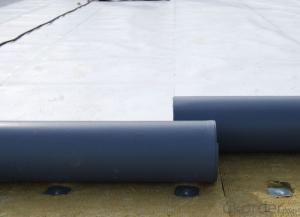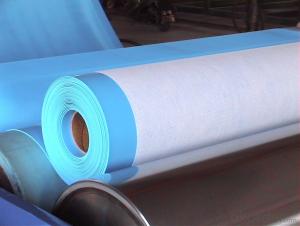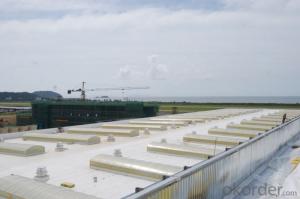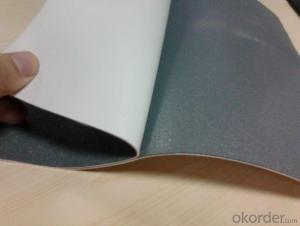0.5MM-2MM TPO Roofing Membrane Waterproof Material
- Loading Port:
- Qingdao Port
- Payment Terms:
- TT or LC
- Min Order Qty:
- 1*20'GP m²
- Supply Capability:
- 20Containers per Month m²/month
OKorder Service Pledge
OKorder Financial Service
You Might Also Like
Description Of 0.5MM-2MM TPO Roofing Membrane Waterproof Material
TPO roofing membrane is typically based on polypropylene and EP (ethylene-propylene) rubber polymerized together using state-of-the-art polymer manufacturing technology. This technology enables the production of TPO membranes that are flexible at low temperatures without the use of polymeric or liquid plasticizers. Unlike some other popular thermoplastic roofing membranes, the TPO polymer does not contain chlorine and no chlorine-containing ingredients are added during sheet production.
The TPO resin is compounded with other components including a weathering package, fire retardants and pigments for color to create a product that can withstand the elements associated with rooftop exposure. The membrane is comprised of TPO based top and bottom plies encapsulating a reinforcing fabric that enhances the physical properties of the sheet. The combination of the fabric and TPO plies provide reinforced membranes with high breaking and tearing strength and puncture resistance. membrane thickness is typically or 1.5 mm (0.045 and 0.060 in.), however, membrane up to 2.0 mm (0.080 in.) is available.
Specification Of 0.5MM-2MM TPO Roofing Membrane Waterproof Material
Thickness: 0.5-2.0mm
Width: 2-2.5M
Length: 20-50M
Install Of 0.5MM-2MM TPO Roofing Membrane Waterproof Material
TPO roofing membrane is typically installed using mechanical fasteners and plates placed along the edge of the sheet and fastened through the membrane and into the roof decking.Adjoining sheets of TPO membrane are overlapped, covering the fasteners and plates, and joined together with a minimum 40 mm (1 1/2 in.) wide hot air weld.
Pictures Of Heat Sealing Property Metalized CPP Film From China
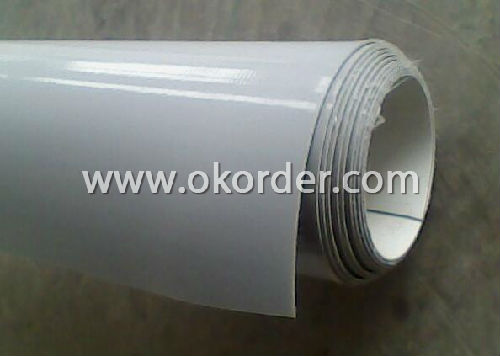
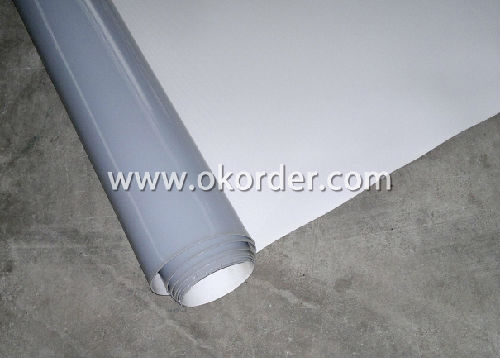
- Q: Are there any specific requirements for installing a waterproofing membrane?
- Yes, there are specific requirements for installing a waterproofing membrane. Some key requirements include ensuring a clean and dry surface, proper preparation of the substrate, correct application of the membrane according to manufacturer's instructions, and adequate curing time. Additionally, ensuring proper seam and joint treatments, as well as sufficient overlap and termination details, are essential for an effective waterproofing installation. It is crucial to follow the specific guidelines and recommendations provided by the manufacturer to ensure a successful and long-lasting waterproofing system.
- Q: Does a waterproofing membrane require any specific surface preparation?
- Yes, a waterproofing membrane does require specific surface preparation before installation. The success and effectiveness of the membrane largely depend on the quality and condition of the surface it is applied to. Firstly, the surface needs to be clean and free from any dirt, debris, oil, grease, or loose particles. This can be achieved by thoroughly cleaning the surface using a pressure washer, scrub brush, or appropriate cleaning agents. Any existing coatings or sealants should also be removed to ensure proper adhesion of the membrane. Secondly, the surface should be smooth and even. Any uneven areas, cracks, or holes should be repaired and leveled before applying the membrane. This can be done by filling the cracks or holes with a suitable filler or patching compound and smoothing it out to create a uniform surface. Thirdly, the surface should be dry. Moisture can compromise the adhesion and effectiveness of the waterproofing membrane. Therefore, it is important to ensure that the surface is completely dry before starting the installation. This may require allowing the surface to air dry or using appropriate drying methods such as fans or dehumidifiers. In addition to these general surface preparations, specific types of waterproofing membranes may have additional requirements. For example, some membranes may require a primer to be applied on the surface before installation. It is essential to follow the manufacturer's instructions and recommendations for the specific membrane being used. Overall, proper surface preparation is crucial for the success of a waterproofing membrane installation. It ensures optimal adhesion, durability, and performance of the membrane, ultimately preventing water penetration and protecting the underlying structure.
- Q: Can a waterproofing membrane be applied over existing coatings?
- Yes, a waterproofing membrane can be applied over existing coatings. However, it is important to note that the success of the application will depend on several factors such as the condition and compatibility of the existing coatings, the type of waterproofing membrane being used, and the surface preparation prior to application. It is recommended to consult with a professional or the manufacturer of the waterproofing membrane for specific guidance and instructions on the application process. Additionally, a thorough inspection of the existing coatings should be conducted to ensure they are in good condition and suitable for the application of the waterproofing membrane.
- Q: Can a waterproofing membrane be installed by a homeowner, or is professional installation necessary?
- Depending on the complexity and scale of the project, a homeowner may choose to install a waterproofing membrane themselves or hire professionals. Waterproofing membranes serve to prevent water penetration in basements, roofs, or shower enclosures. For uncomplicated tasks like sealing a small basement crack, homeowners with some DIY experience can typically handle the installation of a waterproofing membrane. The market offers a variety of do-it-yourself products that come with user-friendly instructions. These products often include self-adhesive membranes or liquid waterproofing coatings that can be applied using a brush or roller. However, for larger or more intricate waterproofing projects, it is advisable to seek professional assistance. Professional waterproofing companies possess the necessary expertise, specialized tools, and experience to ensure a proper and long-lasting installation. They can assess the specific requirements of the project, identify potential problem areas, and recommend the most suitable waterproofing membrane system. Additionally, professional installation typically includes warranties that provide peace of mind and protection against future issues. To summarize, while homeowners can handle small and straightforward waterproofing projects, it is recommended to consult professionals for larger or more complex installations to achieve optimal results and long-term durability.
- Q: Can a waterproofing membrane be used for a water tank liner?
- Indeed, a water tank liner can utilize a waterproofing membrane. The main purpose of waterproofing membranes is to obstruct water infiltration and can be employed on various surfaces, such as concrete, metal, and other commonly used materials in water tank construction. These membranes establish a barrier that thwarts leakage, cracks, and other types of water harm, thus guaranteeing the water tank's strength and durability. Moreover, waterproofing membranes are usually flexible, enabling them to adapt to the tank's shape and accommodate any potential movement or settlement. However, it is crucial to select a waterproofing membrane specifically engineered for water tank applications to ensure optimal performance and long-lastingness.
- Q: Can a waterproofing membrane be used on precast gypsum surfaces?
- Precast gypsum surfaces, commonly utilized in construction for various building components like walls and ceilings, can benefit from the application of a waterproofing membrane. Without proper protection, these porous surfaces are susceptible to water damage. To safeguard precast gypsum, a waterproofing membrane serves as a barrier, preventing water infiltration. By creating a protective layer, it halts the seepage of water into the gypsum, thereby averting issues such as mold growth and deterioration. Multiple types of waterproofing membranes are available in the market, including liquid-applied membranes, sheet membranes, and cementitious coatings. These versatile options can adhere effectively to precast gypsum and other surface materials. When employing a waterproofing membrane on precast gypsum, it is vital to ensure the surface is devoid of any contaminants that could hinder the membrane's adhesion. The application process should adhere to the manufacturer's instructions, taking into account factors like temperature, humidity, and drying time. In summary, the application of a waterproofing membrane on precast gypsum surfaces is indeed possible and highly recommended for protection against water damage. Selecting the appropriate membrane type and following proper application techniques are crucial for optimal efficacy.
- Q: Are waterproofing membranes resistant to soil chemicals?
- Yes, waterproofing membranes are typically resistant to soil chemicals. These membranes are designed to provide a barrier against water and moisture, and they are often made from materials that are resistant to various chemicals found in the soil. This resistance helps to protect the membrane from degradation or damage that could be caused by exposure to soil chemicals. Additionally, waterproofing membranes are often tested and certified to meet specific industry standards and regulations, which include resistance to soil chemicals. However, it is important to note that the level of resistance may vary depending on the specific type and quality of the waterproofing membrane used. Therefore, it is crucial to select the appropriate membrane that is specifically designed to withstand the soil conditions and chemicals present in the project area. Consulting with a professional or manufacturer can provide further guidance on the best waterproofing membrane for a specific application.
- Q: Can a waterproofing membrane be used for a retaining wall drainage?
- Yes, a waterproofing membrane can be used for retaining wall drainage. The membrane helps to prevent water from seeping into the retaining wall and causing damage. Additionally, it can also help to channel water away from the wall, promoting proper drainage.
- Q: Can a waterproofing membrane be used on stone surfaces?
- Yes, a waterproofing membrane can be used on stone surfaces. Waterproofing membranes are designed to protect various materials from water damage, including stone. They create a barrier that prevents water penetration, helping to preserve the integrity and longevity of the stone surface.
- Q: Can a waterproofing membrane be used for elevator pits?
- Yes, a waterproofing membrane can be used for elevator pits. Elevator pits are prone to water infiltration, and using a waterproofing membrane can help prevent water seepage and protect the elevator shaft from potential damage.
1. Manufacturer Overview
| Location | Shandong, China |
| Year Established | 2003 |
| Annual Output Value | Above 50 Million RMB |
| Main Markets | Mid East; Eastern Europe; North America; Southeast Asia |
| Company Certifications | ISO 9001; ISO 14000 |
2. Manufacturer Certificates
| a) Certification Name | |
| Range | |
| Reference | |
| Validity Period |
3. Manufacturer Capability
| a) Trade Capacity | |
| Nearest Port | Tianjin; Qingdao |
| Export Percentage | 10% |
| No.of Employees in Trade Department | 5-10 People |
| Language Spoken: | English; Chinese |
| b) Factory Information | |
| Factory Size: | Above 2000 square meters |
| No. of Production Lines | Above 5 |
| Contract Manufacturing | OEM Service Offered; Design Service Offered |
| Product Price Range | Negotiated |
Send your message to us
0.5MM-2MM TPO Roofing Membrane Waterproof Material
- Loading Port:
- Qingdao Port
- Payment Terms:
- TT or LC
- Min Order Qty:
- 1*20'GP m²
- Supply Capability:
- 20Containers per Month m²/month
OKorder Service Pledge
OKorder Financial Service
Similar products
Hot products
Hot Searches
Related keywords
